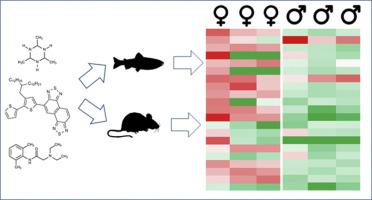Journal of Proteomics ( IF 3.3 ) Pub Date : 2018-04-10 , DOI: 10.1016/j.jprot.2018.03.018 Xuefang Liang 1 , April Feswick 2 , Denina Simmons 3 , Christopher J Martyniuk 4

|
Molecular initiating events and downstream transcriptional/proteomic responses provide valuable information for adverse outcome pathways, which can be used predict the effects of chemicals on physiological systems. There has been a paucity of research that addresses sex-specific expression profiling in toxicology and due to cost, time, and logistic considerations, sex as a variable has not been widely considered. In response to this deficiency, federal agencies in the United States, Canada, and Europe have highlighted the importance of including sex as a variable in scientific investigations. Using case studies from both aquatic and mammalian toxicology, we report that there can be less than ~ 20–25% consensus in how the transcriptome and proteome of each sex responds to chemicals. Chemicals that have been shown to elicit sex-specific responses in the transcriptome or proteome include pharmaceuticals, anti-fouling agents, anticorrosive agents, and fungicides, among others. Sex-specific responses in the transcriptome and proteome are not isolated to whole animals, as investigations demonstrate that primary cell cultures isolated from each sex responds differently to toxicants. This signifies that sex is important, even in cell lines. Sex has significant implications for predictive toxicology, and both male and female data are required to improve robustness of adverse outcome pathways.
Biological significance
Clinical toxicology recognizes that sex is an important variable, as pharmacokinetics (ADME; absorption, distribution, metabolism, and excretion) can differ between females and males. However, few studies in toxicology have explored the implication of sex in relation to the transcriptome and proteome of whole organisms. High-throughput molecular approaches are becoming more frequently applied in toxicity screens (e.g. pre-clinical experiments, fish embryos, cell lines, synthetic tissues) and such data are expected to build upon reporter-based cell assays (e.g. receptor activation, enzyme inhibition) used in toxicant screening programs (i.e. Tox21, ToxCast, REACH). Thus, computational models can more accurately predict the diversity of adverse effects that can occur from chemical exposure within the biological system. Our studies and those synthesized from the literature suggest that the transcriptome and proteome of females and males respond quite differentially to chemicals. This has significant implications for predicting adverse effects in one sex when using molecular data generated in the other sex. While molecular initiating events are not expected to differ dramatically between females and males (i.e. an estrogen binds estrogen receptors in both sexes), it is important to acknowledge that the downstream transcriptomic and proteomic responses can differ based upon the presence/absence of co-regulators and inherent sex-specific variability in regulation of transcriptional and translational machinery. Transcriptomic and proteomic studies also reveal that cell processes affected by chemicals can differ due to sex, and this can undoubtedly lead to sex-specific physiological responses.
中文翻译:

转载:环境毒理学和组学:一个性别问题
分子起始事件和下游转录/蛋白质组反应为不良结果途径提供了有价值的信息,可用于预测化学物质对生理系统的影响。很少有研究涉及毒理学中的性别特异性表达谱,并且由于成本、时间和后勤方面的考虑,性别作为一个变量尚未被广泛考虑。针对这一缺陷,美国、加拿大和欧洲的联邦机构强调了将性别作为一个变量纳入科学调查的重要性。使用来自水生和哺乳动物毒理学的案例研究,我们报告说,对于每种性别的转录组和蛋白质组如何对化学物质作出反应,共识可能不到 20-25%。已显示在转录组或蛋白质组中引发性别特异性反应的化学物质包括药物、防污剂、防腐剂和杀菌剂等。转录组和蛋白质组中的性别特异性反应并不局限于整个动物,因为研究表明从每种性别分离的原代细胞培养物对毒物的反应不同。这表明性别很重要,即使在细胞系中也是如此。性别对预测毒理学具有重要意义,需要男性和女性数据来提高不良结果途径的稳健性。研究表明,从不同性别分离的原代细胞培养物对毒物的反应不同。这表明性别很重要,即使在细胞系中也是如此。性别对预测毒理学具有重要意义,需要男性和女性数据来提高不良结果途径的稳健性。研究表明,从不同性别分离的原代细胞培养物对毒物的反应不同。这表明性别很重要,即使在细胞系中也是如此。性别对预测毒理学具有重要意义,需要男性和女性数据来提高不良结果途径的稳健性。
生物学意义
临床毒理学认识到性别是一个重要变量,因为药代动力学(ADME;吸收、分布、代谢和排泄)在女性和男性之间可能不同。然而,很少有毒理学研究探讨性别与整个生物体的转录组和蛋白质组的关系。高通量分子方法越来越多地应用于毒性筛选(例如临床前实验、鱼胚胎、细胞系、合成组织),并且这些数据预计将建立在基于报告基因的细胞测定(例如受体激活、酶抑制)的基础上用于毒物筛查计划(即 Tox21、ToxCast、REACH)。因此,计算模型可以更准确地预测生物系统内化学暴露可能发生的不利影响的多样性。我们的研究和从文献中合成的研究表明,雌性和雄性的转录组和蛋白质组对化学物质的反应非常不同。当使用在另一性别中产生的分子数据时,这对于预测一种性别的不良反应具有重要意义。虽然预计女性和男性之间的分子起始事件不会有显着差异(即雌激素与雌激素受体在两性中结合),但重要的是要承认下游转录组和蛋白质组反应可能因共同调节剂的存在/不存在而不同以及转录和翻译机制调节中固有的性别特异性变异性。转录组学和蛋白质组学研究还表明,受化学物质影响的细胞过程可能因性别而异,



























 京公网安备 11010802027423号
京公网安备 11010802027423号